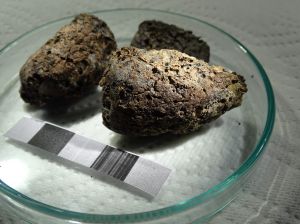Start of the project 'Neolithic human diet'
21 augustus 2019
Commissioned by the Cultural Heritage Agency of the Netherlands (RCE), BIAX Consult Biological Archaeology & Landscape Reconstruction is leading the project ‘Neolithic human diet’ based on studies of human coprolites from Swifterbant sites excavated before 2007. A group of specialists from BIAX Consult, Delft University of Technology, Newcastle University (UK), Universitat Autònoma de Barcelona (Spain), and ArchaeoBone will be working together, incorporating their own research methods.
The sites of interest for this project are defined as wetland sites and are located in two research areas. One is the Swifterbant area in the province of Flevoland where the sites are located in the creek landscape on riverbank dunes and small natural levees, and are dated to the Middle Neolithic (the ‘classic’ phase, 4300- 4000 cal. BC). There are two sites of primary interest in the Swifterbant area: Swifterbant S3 (excavated between 1972-1977) and Swifterbant S4 (excavated between 2005-2007). At both sites, many faecal remains were found during the excavations in the refuse layers.
The other area is the Rhine-Meuse delta in the western part of the Netherlands with the river dune sites dated between 6000-4000 cal. BC. The transition from the Late Mesolithic to Early Swifterbant has been well-documented in this area. The site of Hardinxveld-Giessendam is of our primary interest in this area.
The coprolites are in fact the ‘missing links’ in our knowledge of the prehistoric diet, as they offer direct evidence for dietary diversity, preparation of food and consumption. The study of coprolites gives a unique opportunity to reconstruct the most complete spectrum of foods that were consumed, both cooked meals and (plant) foods that were not cooked in ceramic vessels. Plant foods that were eaten raw as green vegetables, for example, have very little chance of being preserved in any other archaeological record than faecal remains. Even though leaf or stem tissues of herbaceous plants are occasionally found in charred food residues encrusted on ceramics, and as such indicate that some green vegetables were cooked, a large variety of plants and their green parts would have been eaten raw.
The main research questions of our project are concerned with the dietary diversity in the Swifterbant tradition, with attention to both plant and animal components. The evidence for the consumption of plant foods in general, and of cereals in particular, is of our great interest.
We believe that with human coprolites we can answer more research questions on a more detailed level. What were the Swifterbant peoples’ daily meals? How much cereal did they eat? Can the crucial dietary shift, the introduction of cereals to the Swifterbant diet (from c. 4300 cal BC), be identified and evaluated more accurately? We will keep you posted.


Box with c. 300 coprolites from Swifterbant, site S3 in the archaeological depot of the Province of Flevoland in Lelystad.


Individual feacal remains from Swifterbant S3 site - hopefully some are of human origin.
Research Team ‘Neolithic human diet’
In order to best answer the questions about the Neolithic diet using the study of human coprolites, a group of specialists from different disciplines will be working together, incorporating their own research methods. All the specialists have extensive research experience in the field of past human subsistence and diet.
The research team consists of specialists from BIAX Consult (NL), Delft University of Technology (NL), Newcastle University (UK), Universitat Autònoma de Barcelona (Spain), and ArchaeoBone (NL).
In the early stage of the research, Dr. Helen Mackay (Newcastle University) will contribute GC/MS analyses to the project. The assessment of sterols and bile acids biomarkers (together given the term 'faecal steroids') will enable the identification of human coprolites. Dr. Mackay will also investigate the sterol signals to identify animal versus plant contribution to the Swifterbant diet.
Dr. ir. Dominique Ngan-Tillard (Delft University of Technology), will use the micro-CT scanner to inspect the internal structures of the coprolites and to micromorphologically identify the presence of bone fragments and plant tissues embedded in coprolite matrices. Dr. ir. Ngan-Tillard will produce 3D digital models so that the ecofacts can be visualised and 3D-printed. Dr. Lucy Kubiak-Martens (BIAX Consult) will use the scanning electron microscope (SEM) for further extraction and determination of plant tissues at areas identified on the micro-CT scans. Under the SEM microscope, even very small fragments of plant tissues can be identified to the species level, giving the possibility to learn more about plant species and plant parts that were consumed. In past years, Dr. Kubiak-Martens has worked on food residues encrusted on Swifterbant ceramics (from sites S3, S25, currently also S4), where the main research questions were concerned with methods of food preparation, diversity of diet and evidence for the consumption of cereals. The results of these studies will help to better understand the dietary patterns and traditions of food preparation in the Swifterbant culture. In addition to plant tissues, the study of fragmented bones embedded in coprolite matrices will also be carried out in the project. Dr. Jørn Zeiler (ArchaeoBone) will identify fragmented bones embedded in coprolite matrices.
Dr. Frederike Verbruggen and Dr. Marjolein van der Linden (both BIAX Consult) will examine pollen and intestinal parasites contained in the studied faecal remains for evidence of diet, nutrition, and health. Dr. Lisa-Marie Shillito (Newcastle University) will contribute phytolith analyses and Dr. Karen Hardy (Universitat Autònoma de Barcelona) will contribute starch analyses to the project.
The project will be coordinated by Lucy Kubiak-Martens. She will monitor the progress of the project and coordinate contacts between the specialists. All the specialists will be responsible for writing individual chapters according to their specialization and analysis contributed to the project. All specialists will also be involved in writing the final synthesis. The results of the project will be published as a NAR (Nederlandse Archeologische Rapporten) publication in English



